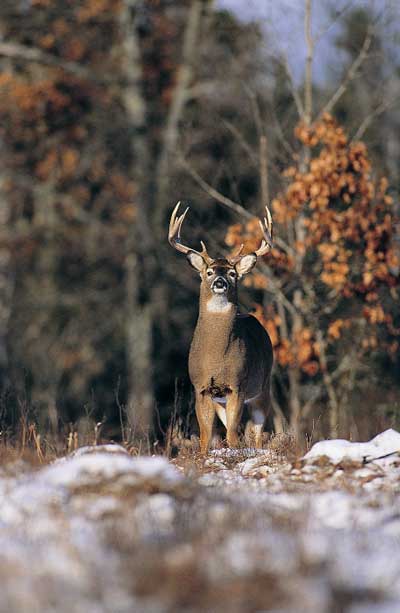Previously: Calling Blind, Sight Calling
 Mouth And Hand Calls
Mouth And Hand Calls
Manufacturers offer a wide range of calls to get the job done.
Many standard reed-type deer calls produce a single sound that is controlled by the air pressure of exhaling or inhaling, as well as by muffling the end of the call. The advantage of a single note call is that you can’t accidentally use it on the wrong setting should you suddenly become unnerved by heavy antlers. Also, some hunters believe a call tweaked to mimic a particular vocalization makes a more natural sound than an adjustable call that tries to cover all the bases. High-pitched fawn bleats, for example, are generally better emulated with calls without extension tubes. The deep grunt of a dominant buck, on the other hand, is hard to duplicate without a tube.
Adjustable reed calls can effectively generate everything from buck grunts to fawn bleats. They are cost-effective because they eliminate the need for multiple calls, also shortening the ever-growing list of “necessities” we deer hunters carry afield..
Hands-free calls are ideal for close work when you need to have both hands on your bow. They are also ideal for stopping a buck in a shooting lane after you have drawn your bow.
In the hand-operated category, “can” calls look like oversized salt and pepper shakers and are pretty much foolproof. Simply tip the can over and it produces the pleading bleat of a doe in estrus.
With other hand calls, you drag the striker along the side of the call’s ridges to produce authentic rattling sounds, or you squeeze and release rubber bellows to make buck or doe grunts.
Whatever call or calls you choose, be sure to match the proper sounds to the phase of the deer season you are hunting. Above all, believe in them! Calling works, provided you stay with the program. With plenty of practice and persistence, you soon may be producing music to the ears of your best buck!
Calling Setups
In order for calls to be effective, avoid setting up in areas where deer can see for long distances. A treestand in a mature, open wood lot would be a poor choice for a bowhunter because any whitetail that responds to a call could easily see no deer are present. A young deer may foolishly step into range, but a mature buck isn’t likely to make that mistake.
An ideal setup is a stand in some type of funnel on the edge of thick cover, adjacent to a field or open woods. No deer trails need be present. In such a spot, you could see deer at a distance and convince them that your calls are coming from within the thicket. Since deer can’t see into the cover, they have no choice but to come closer if they want to determine the source of the call.
Prime-Time Calling
Deer calls are most effective from the early bow season through the rut. The pre-rut is prime time for sweet talking trophy whitetails because this is when bucks travel widely. Pre-rut bucks are more likely to pass within earshot of your calls, and to respond when they hear them.
Calling is hit or miss during the rut, since most bucks are actually with does that are ready, or nearly ready, for breeding. A buck tending a doe generally won’t respond to a call. He’s already found what he’s looking for.
After the rut, calling is inconsistent at best, with the exception of an active secondary rut. If you try calling after the secondary rut, opt for doe or fawn bleats and call softly and infrequently. Or, wait until you see deer before you call.






